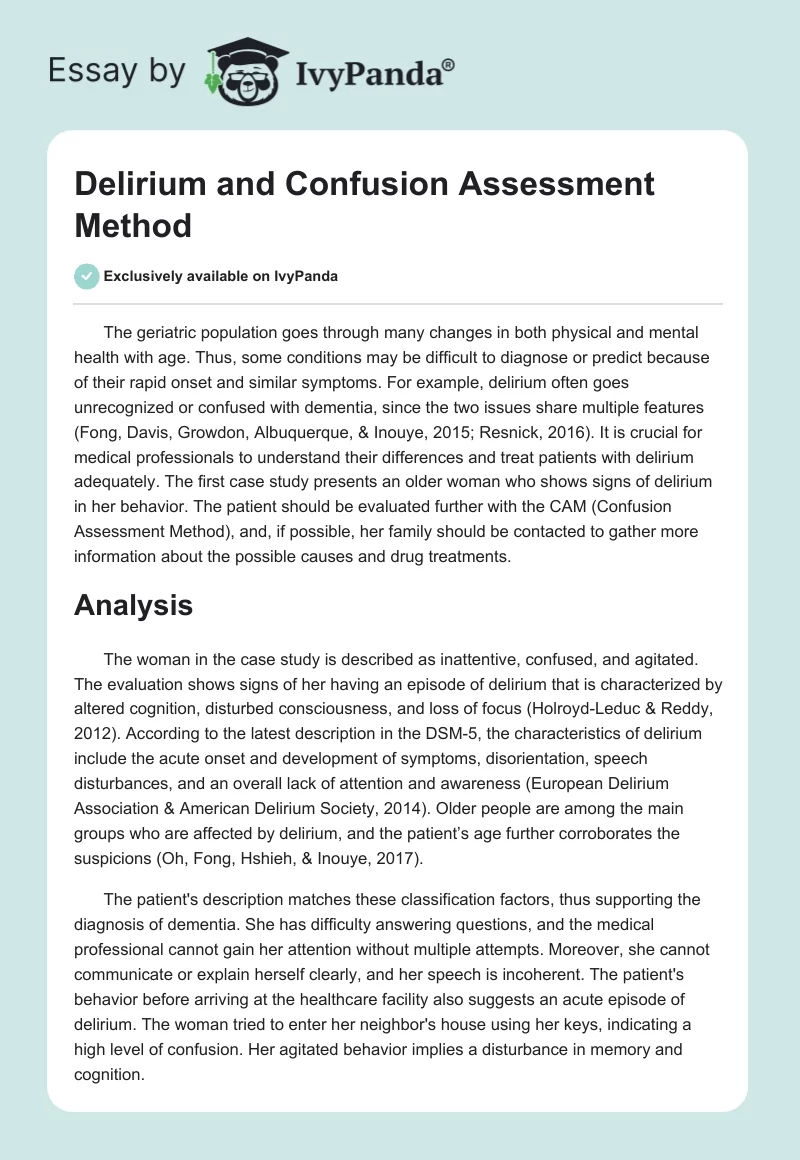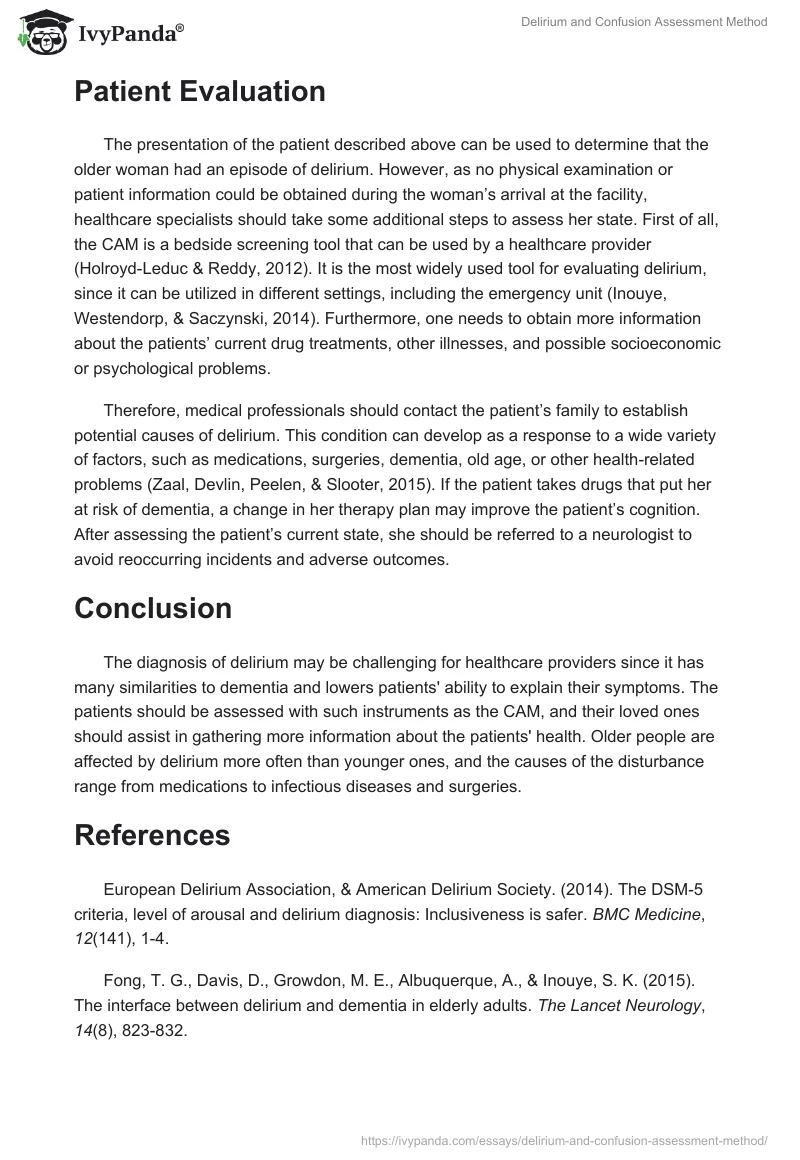The geriatric population goes through many changes in both physical and mental health with age. Thus, some conditions may be difficult to diagnose or predict because of their rapid onset and similar symptoms. For example, delirium often goes unrecognized or confused with dementia, since the two issues share multiple features (Fong, Davis, Growdon, Albuquerque, & Inouye, 2015; Resnick, 2016). It is crucial for medical professionals to understand their differences and treat patients with delirium adequately. The first case study presents an older woman who shows signs of delirium in her behavior. The patient should be evaluated further with the CAM (Confusion Assessment Method), and, if possible, her family should be contacted to gather more information about the possible causes and drug treatments.
Analysis
The woman in the case study is described as inattentive, confused, and agitated. The evaluation shows signs of her having an episode of delirium that is characterized by altered cognition, disturbed consciousness, and loss of focus (Holroyd-Leduc & Reddy, 2012). According to the latest description in the DSM-5, the characteristics of delirium include the acute onset and development of symptoms, disorientation, speech disturbances, and an overall lack of attention and awareness (European Delirium Association & American Delirium Society, 2014). Older people are among the main groups who are affected by delirium, and the patient’s age further corroborates the suspicions (Oh, Fong, Hshieh, & Inouye, 2017).
The patient’s description matches these classification factors, thus supporting the diagnosis of dementia. She has difficulty answering questions, and the medical professional cannot gain her attention without multiple attempts. Moreover, she cannot communicate or explain herself clearly, and her speech is incoherent. The patient’s behavior before arriving at the healthcare facility also suggests an acute episode of delirium. The woman tried to enter her neighbor’s house using her keys, indicating a high level of confusion. Her agitated behavior implies a disturbance in memory and cognition.
Patient Evaluation
The presentation of the patient described above can be used to determine that the older woman had an episode of delirium. However, as no physical examination or patient information could be obtained during the woman’s arrival at the facility, healthcare specialists should take some additional steps to assess her state. First of all, the CAM is a bedside screening tool that can be used by a healthcare provider (Holroyd-Leduc & Reddy, 2012). It is the most widely used tool for evaluating delirium, since it can be utilized in different settings, including the emergency unit (Inouye, Westendorp, & Saczynski, 2014). Furthermore, one needs to obtain more information about the patients’ current drug treatments, other illnesses, and possible socioeconomic or psychological problems.
Therefore, medical professionals should contact the patient’s family to establish potential causes of delirium. This condition can develop as a response to a wide variety of factors, such as medications, surgeries, dementia, old age, or other health-related problems (Zaal, Devlin, Peelen, & Slooter, 2015). If the patient takes drugs that put her at risk of dementia, a change in her therapy plan may improve the patient’s cognition. After assessing the patient’s current state, she should be referred to a neurologist to avoid reoccurring incidents and adverse outcomes.
Conclusion
The diagnosis of delirium may be challenging for healthcare providers since it has many similarities to dementia and lowers patients’ ability to explain their symptoms. The patients should be assessed with such instruments as the CAM, and their loved ones should assist in gathering more information about the patients’ health. Older people are affected by delirium more often than younger ones, and the causes of the disturbance range from medications to infectious diseases and surgeries.
References
European Delirium Association, & American Delirium Society. (2014). The DSM-5 criteria, level of arousal and delirium diagnosis: Inclusiveness is safer. BMC Medicine, 12(141), 1-4.
Fong, T. G., Davis, D., Growdon, M. E., Albuquerque, A., & Inouye, S. K. (2015). The interface between delirium and dementia in elderly adults. The Lancet Neurology, 14(8), 823-832.
Holroyd-Leduc, J., & Reddy, M. (Eds.). (2012). Evidence-based geriatric medicine: A practical clinical guide. Hoboken, NJ: Blackwell Publishing.
Inouye, S. K., Westendorp, R. G., & Saczynski, J. S. (2014). Delirium in elderly people. The Lancet, 383(9920), 911-922.
Oh, E. S., Fong, T. G., Hshieh, T. T., & Inouye, S. K. (2017). Delirium in older persons: Advances in diagnosis and treatment. JAMA, 318(12), 1161-1174.
Resnick, B. (Ed.). (2016). Geriatric nursing review syllabus: A core curriculum in advanced practice geriatric nursing (5th ed.). New York, NY: American Geriatrics Society.
Zaal, I. J., Devlin, J. W., Peelen, L. M., & Slooter, A. J. (2015). A systematic review of risk factors for delirium in the ICU. Critical Care Medicine, 43(1), 40-47.


